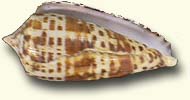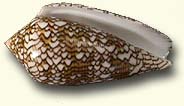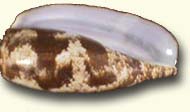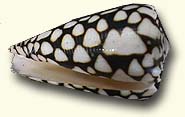Cone shell
| Cone shell Conidae "For centuries members of the Conidae family have been collected for their unique and intricately designed shells. Only during the last few decades have cone shells become an exciting area for scientific research." |
"Cone shells are marine snails and are found in reef environments throughout the world. They prey upon other marine organisms, immobilizing them with unique venom. There have been 30 recorded cases of human envenomation by fish-eating cone shells, in some cases fatal. Upon investigation it was found that toxins in cone shell venom possess pharmacological qualities that make them valuable tools in medical research.
In the dynamic marine environment in which cone shells reside, it has been necessary for these gastropods to develop an effective mechanism for immobilizing their otherwise speedy prey.The solution to the snail's lack of physical agility has been the development of a highly potent concoction of neuronal toxins, which it uses to paralyze its prey (an especially vital factor for the fish eating species).
Cone shells can be classified according to their prey:
- Piscivorousfish eaters
- Molluscivorousmollusk eaters
- Vermivorousworm eatersDetection of the Prey
The cone shell detects prey in its environment using a "siphon" which bristles with chemoreceptors. It then extends its proboscis out towards the unfortunate target.
 Conus lynceus Vietnam |  Conus armadillo Phillipines |
 Conus textile Cloth of gold cone Queensland to N. of WA |  Conus geographus Geographer cone Queensland to N. of WA |
 Conus tulipa Tulip cone Queensland |  Conus marmoreus Marbled cone Queensland |
Injection of the venom
The venom is produced in a long tubular duct that is often several times the length of the snail itself and at one end is attached to a muscular bulb which is thought to contract to provide the necessary force of venom injection through the 'tooth'. Hollow spear-like radular teeth, which are made in the 'radular sac' and filled with venom, are transported through the 'buccal cavity' to the tip of the proboscis where they are retained by radular muscle.Upon contact with the prey, the proboscis impales the harpoon like tooth into any exposed tissue and injects the venom through this. The harpoon is attached to the gastropod via a 'thread' so that the prey is actually tethered to the snail (although the organism is often paralyzed within one or two seconds, leaving little opportunity to escape). Once the prey is paralyzed, the gastropod retracts the cord by which the prey is attached and engulfs the prey through it's the radular opening of it's proboscis and into its distensible stomach where it is digested. The cone shell can reload further teeth from the radular sac for multiple envenomation by retracting the proboscis into the radular sac and grasping another tooth with the radular muscle.
Composition of the Venom
The composition of the venom differs greatly between species and between individual snails within each species, each optimally evolved to paralyze its prey. The active components of the venom are small peptides toxins, typically 12-30 amino acid residues in length and are highly constrained peptides due to their high density of disulfide bonds.The composition of the venom is different with each injection. The pharmacological activity also changes, the venom containing lethal and paralytic neurotoxic peptides as well as components which elicit specific and varied physiological and behavioral responses when tested in mice, from shaking to depression! The paralysis of the prey by the killer-snail venom permits correct presentation of the prey to the gastropod so that it engulfed and enzymatically digested by the killer snail's distensible stomach.
The paralytic components of the venom that have been the focus of recent investigation are the alpha-, omega- and mu-conotoxins. All of these conotoxins act by preventing neuronal communication, but each targets a different aspect of the process to achieve this. The alpha-conotoxins target nicotinic ligand gated channels, the mu-conotoxins target the voltage-gated sodium channels and the omega-conotoxins target the voltage-gated calcium channels."
First aid for Cone shell stings
The venom of these creatures contains a number of neurotoxic peptides that cause weakness and loss of coordination. The victims vision, speech and hearing are disturbed. Nausea and general pruritis are some of the less common symptoms. Numbness, local pain and swelling may also occur. In cases of severe envenomation, respiratory muscle paralysis may lead to death. Pressure-immobilization should be used and, if necessary, assisted ventilation. There is no antivenom developed for cone snail stings. Because the wound can be contaminated, tetanus prophylaxis should be performed.
Quoted text and images copyright © Bruce Livett Cone Shell and Conotoxins Page |
